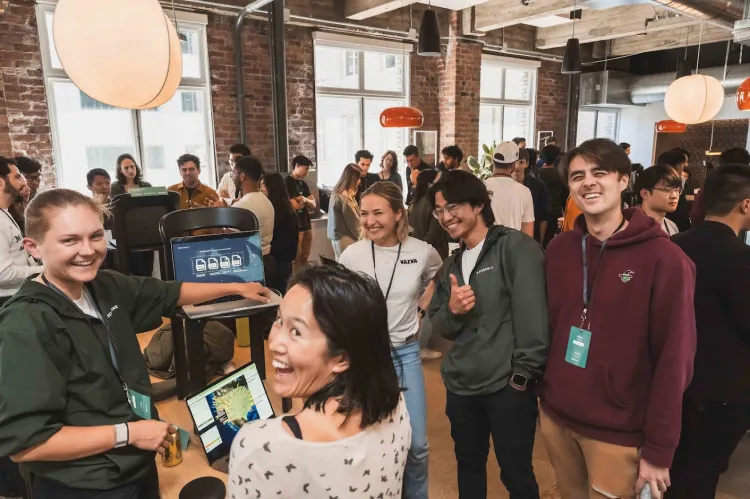From code to impact: Devs unleash AI in energy at Crusoe’s hackathon
In a 24-hour hackathon hosted by Crusoe Energy and Lowercarbon Capital, developers demonstrated the remarkable speed at which AI can tackle longstanding challenges in the clean energy sector. The event, held in San Francisco on June 28-29, 2024, showcased how AI tools can compress months or years of traditional work into mere hours, potentially revolutionizing clean energy deployment.

By: James Thomason
In a 24-hour hackathon hosted by Crusoe Energy and Lowercarbon Capital, developers demonstrated the remarkable speed at which AI can tackle longstanding challenges in the clean energy sector. The event, held in San Francisco on June 28-29, 2024, showcased how AI tools can compress months or years of traditional work into mere hours, potentially revolutionizing clean energy deployment.
The winning team, Verdigris, exemplified this swift transformation by developing an AI system that addresses key barriers in home electrification. Their tool analyzes mortgage data to identify qualified homeowners for zero-cost upgrades and generates personalized marketing materials, including AI-created images of homes with proposed improvements. This level of personalization and automation could significantly accelerate the adoption of home energy upgrades.
Verdigris’s system integrates with bank databases to access mortgage information, income data and property details. It then uses this data to determine eligibility for various energy upgrade incentives. The team leveraged the Eli API to calculate available tax credits and rebates, ensuring that recommendations are tailored to each homeowner’s specific situation. Perhaps most impressively, the system employs DALL-E, an advanced image generation AI, to create realistic before-and-after visuals of each property with proposed upgrades. This visual component makes the benefits of energy improvements tangible and compelling for homeowners.
Other projects further illustrated AI’s transformative potential. The Daylight team created a system that rapidly extracts and maps complex stakeholder relationships from dense permitting documents – a task that traditionally takes months. Their AI uses natural language processing to identify key entities, their roles, and interconnections within thousands of pages of regulatory and permitting documents. The team built a graph database to store and visualize these relationships, allowing users to quickly navigate the complex web of stakeholders involved in energy projects. They even implemented a voice assistant interface, enabling users to query the system using natural language.
Project Aria developed an AI that can analyze environmental impact statements and link them to relevant legal precedents in seconds, potentially saving years in the permitting process. The team’s solution chunks large environmental documents and processes them in parallel, using AI to identify key risk factors such as endangered species mentions and historical preservation issues. It then cross-references these findings with a database of historical legal cases, providing a comprehensive risk assessment for each project. This approach could dramatically reduce the time and expertise required to navigate complex environmental regulations.
The NEPA Ninjas team demonstrated AI’s ability to process vast amounts of regulatory data at unprecedented speeds. Using advanced techniques like map-reduce, they built a system that quickly identifies similar past projects and potential roadblocks, showcasing how AI can navigate complex regulatory landscapes far faster than human experts. Their platform ingests historical project data, including locations, timelines, and outcomes, and uses this information to predict potential challenges for new projects. The team implemented a geospatial interface, allowing users to visualize projects and their associated risks across different regions.
The hackathon also highlighted AI’s potential to address data scarcity in emerging markets. The Carbon Connect team used AI to generate synthetic market data for carbon credits, potentially accelerating the growth of this crucial financial instrument for clean energy projects. Their system employs a combination of machine learning (ML) techniques to create realistic, statistically valid market data. It starts by generating samples using Gaussian distributions, then applies business rules derived from expert knowledge of the carbon credit market. The team then used a large language model to validate individual data points, ensuring they make sense in a real-world context. This synthetic data could help bootstrap liquidity in nascent carbon credit markets, providing valuable insights for traders and policymakers alike.
“What we’ve witnessed here is the future of energy infrastructure being rewritten in real-time,” said Patrick McGregor, VP of Product at Crusoe Energy. “These AI-powered solutions are tackling complex challenges that have hindered clean energy deployment for decades.”
This rapid pace of innovation in the energy sector, where projects often move slowly due to regulatory and technical complexities, suggests a broader trend of AI swiftly reshaping industries. As these AI tools move from prototypes to production, they could redefine the speed at which we transition to a sustainable energy future, compressing timelines and improving decision-making across the industry.
The event serves as a microcosm of the AI-driven revolution happening across various sectors. In just 24 hours, it offered a glimpse into a future where complex industry challenges are solved at the speed of thought, powered by artificial intelligence. As AI continues to evolve at breakneck speed, industries long constrained by information bottlenecks and complex decision-making processes may see radical transformations in efficiency and scale.
Table: Summary of Hackathon Projects and Approaches
Project Name
Problem Solved
Tools/Technologies
Languages/Frameworks
AI/ML Models
Verdigris
Home electrification
Bank database integration, Eli API
Python, SQL, REST APIs
DALL-E, Custom ML models for eligibility prediction
Daylight
Stakeholder mapping
Natural Language Processing, Graph database
Python, Neo4j or similar
LLM, Voice recognition model
Project Aria
Environmental impact analysis
Parallel processing, Legal database
Python, Parallel computing frameworks
Custom NLP models for document analysis
NEPA Ninjas
Regulatory data processing
Map-reduce, Geospatial interface
Python, Hadoop or Spark for map-reduce, GIS tools
Machine learning models for risk prediction
Carbon Connect
Synthetic carbon credit data
Gaussian distributions, Machine learning
Python, Possibly R for statistical modeling
Large Language Model, Custom ML models
Crusoe Energy joins GPU cloud providers reshaping AI Infrastructure
The hackathon’s host, Crusoe Energy, is transforming itself from flared gas Bitcoin mining to a sustainable AI powerhouse, and exemplifies a growing trend in specialized GPU cloud services. The company’s plan to build gigawatts of AI-focused, clean-powered data centers positions it alongside emerging players like Lambda Labs, Paperspace and CoreWeave in challenging traditional cloud giants.
In an exclusive interview, Crusoe’s VP of Product, Patrick McGregor, unveiled the company’s ambitious strategy to become a major force in AI infrastructure. “We’re moving very quickly into building AI infrastructure, and we’ve got a big pipeline” McGregor stated, adding that the company is aiming to deliver “gigawatts of new data center capacity.”
Crusoe’s unique selling point in this competitive field is its focus on sustainable energy sources and innovative data center designs. The company has developed a high-density data center form factor optimized for AI hardware. According to McGregor, their 100MW data center design, comprising four 25MW wings, can host up to 100,000 GPUs on a single integrated network fabric.
One of the key advantages touted by these specialized providers is cost-effectiveness. McGregor claimed that Crusoe’s list pricing is less than 50% of what Amazon charges, attributing this to more streamlined operations and access to cheap, sustainable electricity. This pricing strategy aligns with the broader trend of GPU cloud providers offering more competitive rates compared to traditional cloud giants.
The rise of companies like Crusoe in the GPU cloud space comes at a crucial time for the AI industry. As demand for AI compute continues to grow exponentially, these specialized providers are stepping in to offer alternatives that promise not only cost savings but also improved performance and sustainability.
For enterprise technology decision-makers, this trend represents a significant shift in the AI infrastructure landscape. The emergence of these specialized GPU cloud providers offers more options for deploying large AI models and workloads, potentially disrupting the dominance of traditional cloud providers in the AI space.
However, Crusoe and its peers face significant challenges, including the need to scale rapidly and compete with the established resources and ecosystems of major cloud providers. Despite these hurdles, McGregor expressed confidence in Crusoe’s approach, stating, “We have a perpetual, insurmountable advantage over them when it comes to pricing.”
As Crusoe transitions from its crypto mining roots to join the ranks of specialized AI infrastructure providers, it exemplifies the broader industry shift towards more tailored, efficient, and sustainable cloud solutions for AI workloads. The success of these emerging players could reshape the future of AI infrastructure, offering new possibilities for companies looking to harness the power of artificial intelligence.
Takeaways for the Enterprise
For enterprise decision-makers, the innovations showcased at this hackathon and Crusoe Energy’s pivot offer crucial lessons in navigating the AI-driven future:
- AI is dramatically accelerating problem-solving in complex industries, compressing months of work into hours. This could lead to faster project deployments and more efficient operations across all sectors.
- The rise of specialized GPU cloud providers like Crusoe offers new options for AI infrastructure, potentially reducing costs and improving sustainability.
- AI-driven tools are making previously inaccessible data and insights readily available, streamlining decision-making processes and risk assessments for large-scale projects.
- The rapid pace of AI innovation demands that enterprises stay current with these technologies to maintain competitive advantage.
- Most critically, the hackathon format itself presents a powerful model for innovation that all enterprises should consider adopting. Rapid experimentation and iteration, as demonstrated by Crusoe and the hackathon participants, can yield remarkable results in short timeframes.
The success of this event underscores a vital strategy: every enterprise, regardless of industry, should be conducting similar exercises in rapid AI-driven innovation. By organizing internal hackathons, fostering a culture of experimentation, and leveraging AI tools for quick prototyping, companies can unlock novel solutions to longstanding problems and identify new growth opportunities.
As AI continues to evolve, enterprise leaders must do more than stay agile—they must actively drive innovation within their organizations. The companies that can effectively integrate these AI innovations into their operations, decision-making processes, and crucially, their innovation practices, will be the ones leading in an increasingly AI-driven business landscape. The message is clear: in the age of AI, rapid experimentation isn’t just an option—it’s an imperative for staying competitive and relevant.
For the article: https://venturebeat.com/ai/from-code-to-impact-crusoes-hackathon-reveals-ais-power-to-drive-change-in-energy-and-beyond/


